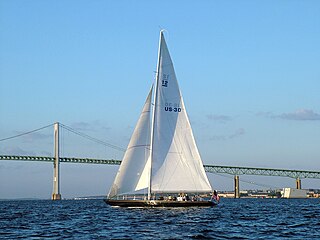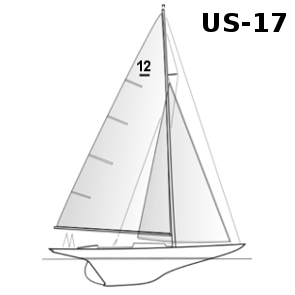
The America's Cup, informally known as the Auld Mug, is a trophy awarded in the sport of sailing. It is the oldest international competition still operating in any sport. America's Cup match races are held between two sailing yachts: one from the yacht club that currently holds the trophy and the other from the yacht club that is challenging for the cup. There is no fixed schedule, with matches held several years apart on dates agreed between the defender and the challenger. The most recent America's Cup match took place in March 2021.

Australia II is an Australian 12-metre-class America's Cup challenge racing yacht that was launched in 1982 and won the 1983 America's Cup for the Royal Perth Yacht Club. Skippered by John Bertrand, she was the first successful Cup challenger, ending a 132-year tenure by the New York Yacht Club.

Stars & Stripes is the name of an America's Cup syndicate operated by Dennis Conner and its racing yachts. The name "Stars & Stripes" refers to the nickname often used for the flag of the United States. TDC was registered under the flag of the San Diego Yacht Club (SDYC).
Benjamin Lexcen AM was an Australian yachtsman and marine architect. He is famous for the winged keel design applied to Australia II which, in 1983, became the first non-American yacht to win the prestigious America's Cup in 132 years.

The 12 Metre class is a rating class for racing sailboats that are designed to the International rule. It enables fair competition between boats that rate in the class whilst retaining the freedom to experiment with the details of their designs. The designation "12 Metre" does not refer to any single measurement on the boat, and is not referencing the vessels overall length, rather, measures the sum of the components directed by the formula which governs design and construction parameters. Typically 12 Metre class boats range from 65 to 75 feet in length overall; they are most often sloop-rigged, with masts roughly 85 feet tall.

Freedom is a 12-metre class racing yacht and winner of the 1980 America's Cup, defeating the challenging yacht Australia under skipper Dennis Conner. Freedom was designed with an alloy rather than a wood hull by Olin Stephens and Bill Langan, and constructed at Minneford Yacht Yard. She was skippered in the Cup by Dennis Conner.

Dame Pattie is an International 12-metre class racing yacht built for the America's Cup challenge series in 1967. She was designed by Warwick Hood and built by W.H. Barnett in New South Wales, Australia.
Olin James Stephens II was an American yacht designer. Stephens was born in New York City, but spent his summers with his brother Rod, learning to sail on the New England coast. He also attended the Massachusetts Institute of Technology for a term.
Courageous is a 12-metre class racing yacht. It was the third boat to win the America's Cup twice, in 1974 and 1977, after Columbia in 1899 and 1901, and Intrepid in 1967 and 1970. All three yachts were fielded by the New York Yacht Club. The Olin J. Stephens-designed sloop was the first all aluminum-hulled 12-metre class yacht.
The 1983 America's Cup was a 12-metre class yacht race which pitted the defending New York Yacht Club's Liberty against the Royal Perth Yacht Club's challenger, Australia II. The September 1983 match race was won by Australia II in the first successful challenge of the New York Yacht Club's 132-year defense of the Cup. The Australian syndicate's boat, skippered by John Bertrand, fought back from a 3-1 deficit to best the Dennis Conner-helmed defender, ending both the longest winning streak in sporting history and U.S. domination of the racing series.
The 2nd Louis Vuitton Cup was held in Fremantle, Western Australia in 1987. The winner, Stars & Stripes, went on to challenge for and win the 1987 America's Cup.
The 1987 Defender Selection Series was raced between four syndicates competing for the right to represent the Royal Perth Yacht Club as the defender of the America's Cup. Kookaburra III won the series and advanced to the 1987 America's Cup. However, they failed to defend the cup from the challenge of Stars & Stripes 87.
Thomas David Blackaller, Jr. was a world-champion American yachtsman, America's Cup helmsman, sailmaker, and racecar competitor. He was a two-time world champion in the Star class keelboat, a world champion in the international Six metre class, raced in three separate America's Cup campaigns, and influenced the careers of many other sailors.

The 1962 America's Cup, the second to be sailed in 12-metre yachts, marked the first challenge for the Cup from a country other than Great Britain or Canada, and was the first challenge from a country in the southern hemisphere. An Australian syndicate headed by Sir Frank Packer, representing the Royal Sydney Yacht Squadron, challenged with their yacht Gretel. Although the New York Yacht Club won the regatta four races to one represented by the yacht Weatherly, the challenger, Gretel won the second race, beating the Americans for the first time since the 1930s, and only lost the fourth race by twenty-six seconds. The NYYC was so shocked at the closeness of the contest that they immediately changed the rules to ban the use of American design and technology by Cup challengers.

Weatherly is a 12-metre racing yacht that was an unsuccessful defense candidate for the 1958 America's Cup and victorious defender in the 1962 America's Cup.

Gretel II (KA-3) is an International 12-metre class racing yacht built for the America's Cup challenge series in 1970. She was designed by Alan Payne and built by W.H. Barnett for Australian media tycoon Sir Frank Packer.
The 1974 America's Cup was held in September 1974 at Newport, Rhode Island. The US defender, Courageous, skippered by Ted Hood, defeated the Australian challenger, Southern Cross, skippered by James Hardy, in a four-race sweep.

Australia (KA–5) is an Australian 12-metre-class America's Cup racing yacht that twice challenged unsuccessfully for the America's Cup in 1977 and 1980. Designed by Ben Lexcen in association with the Dutch designer Johan Valentijn for Alan Bond, Australia failed to win a single race against the 1977 defender, Courageous (US-26), but won one race against the 1980 defender, Freedom (US-30). Australia resides in Sydney, Australia.
Britton Chance, Jr. was an American naval architect yacht designer who helped work on core design elements of craft that won the America's Cup.

Swan 36 is a fin keeled, fiberglass constructed masthead sloop first manufactured by Nautor's Swan in 1967. The first Swan sailing yacht ever produced by the firm, it was designed to serve recreationally but also compete in the One Ton Cup.










